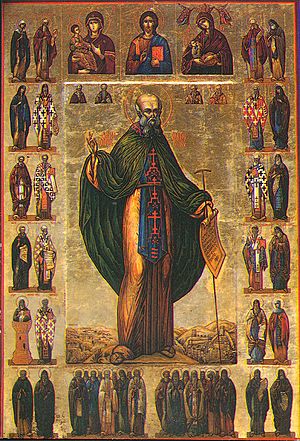Sabbas the Sanctified facts for kids
Quick facts for kids SaintSabbas the Sanctified |
|
|---|---|

Medieval icon of Saint Sabbas the Sanctified
|
|
| Venerable Father; Abbot | |
| Born | 439 Caesarea Mazaca, Cappadocia (modern-day Kayseri, Turkey) |
| Died | December 5, 532 Jerusalem, Palaestina Prima |
| Venerated in | Eastern Orthodox Church Catholic Church |
| Major shrine | Saint Sabbas Monastery, Palestine |
| Feast | December 5 |
| Attributes | Clothed as a monk, often holding a paterissa (abbot's staff) |
Saint Sabas (born in 439, died in 532) was a very important monk and saint from a place called Cappadocia (which is now part of Turkey). He is also known as Sabbas the Sanctified, which means "Sabbas the Holy One." He spent most of his life in the Holy Land (modern-day Palestine).
Saint Sabbas started many monasteries, with the most famous one being Mar Saba. This monastery is still active today in Palestine. His name, Sabbas, comes from an old word meaning "old man."
Contents
Life of Saint Sabbas
His Early Years
Sabbas was born in a village near Caesarea Mazaca (today called Kayseri). His father, John, was a military leader, and his mother was Sophia.
When Sabbas was five years old, his parents went on a trip and left him with an uncle. At age eight, he joined a nearby monastery. He quickly learned to read and became very good at understanding the Holy Scriptures (the Bible). Even though his parents wanted him to leave the monastery and get married, Sabbas chose to stay. He became a monk at 17 and lived at that monastery for ten more years.
Learning in the Holy Land
After his time there, Sabbas traveled to Jerusalem. From Jerusalem, he went to the monastery of Saint Euthymius the Great. Euthymius then sent Sabbas to another monastery led by Abba Theoctistus. This monastery had very strict rules for monks living together. Sabbas followed these rules for many years, until he was 30.
After Abba Theoctistus passed away, Sabbas was allowed to live by himself in a cave. On Saturdays, he would leave his cave to join the other monks for church services and meals. After some time, he received permission to stay in his cave all the time, living alone for five years.
Euthymius, his mentor, carefully guided Sabbas. Seeing how spiritually mature Sabbas was, Euthymius began taking him into the wilderness. They would go out every January 14 and stay until Palm Sunday. Euthymius called Sabbas a "child-elder" because he was young but very wise.
Hermit and Monastery Founder
When Euthymius died around 473, Sabbas moved to another cave. Soon, other people who wanted to live a monastic life started to gather around him. As more monks joined, a large monastery called the Great Lavra was built. This happened in 484 in the Kidron Valley, south of Jerusalem.
A "lavra" is a special type of monastery where monks live in separate cells or caves, but they share a central church and sometimes a dining hall. In Sabbas's lavras, younger monks lived together, while older monks lived more by themselves in their own huts.
Sabbas was a strong supporter of the Chalcedonian Christian beliefs. He disagreed with other groups, like the Monophysites, who had different ideas about Jesus. He even traveled to Constantinople (the capital of the Byzantine Empire) to speak with emperors, asking them to support his beliefs. He met Emperor Anastasios I in 511 and Emperor Justinian I in 531.
Many miracles are said to have happened through Sabbas's prayers. For example, a spring of water appeared at his lavra, and during a dry period, they received plenty of rain. People who were sick or possessed were also healed.
In 491, the Patriarch of Jerusalem, Salustius, made Sabbas a priest. In 494, Sabbas was put in charge of all the monasteries in the area. Sabbas also created the first set of rules for church services in monasteries, called the Jerusalem Typikon. He died on December 5, 532, which is now his feast day.
Relics
After Sabbas died, his relics (his remains) were taken by Crusaders in the 12th century. They were kept in a church in Venice, Italy, for many centuries. However, in 1965, Pope Paul VI returned them to the Mar Saba monastery. This was a kind gesture to show good will towards the Eastern Orthodox Church.
Legacy
The Great Lavra that Saint Sabbas founded continued to be a very important monastery. Many famous monks came from there, including St John of Damascus. Today, it is still known as the monastery of Mar Saba.
A church in Rome, called San Saba, is named after him. Also, the San Saba River in Texas, USA, and other places in that area are named after Saint Sabbas. This is because a Spanish explorer discovered the river on Saint Sabbas's feast day, December 5, 1732. He named it "River of Saint Sabbas of the Walnuts."
See also
- Anthony the Great (c. 251 – 356), a monk who started Christian monasticism in the Egyptian desert.
- Chariton the Confessor (end of 3rd century - ca. 350), who founded lavra-style monasteries in the Judaean desert.
- Euthymius the Great (377–473), a saint and founder of monasteries in Palestine.
- Saint Sabbas the Sanctified, patron saint archive
- Sabbas (disambiguation) (a page listing other people named Sabbas or Sabas).
- Saint Sava (1169/74–1236), a Serbian prince and Orthodox monk who visited Mar Saba.
- In Spanish: Sabas el Santificado para niños


